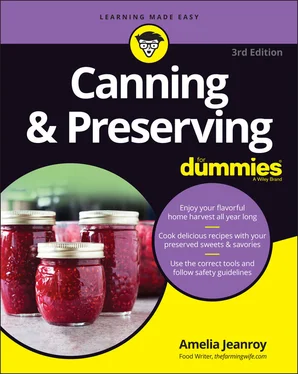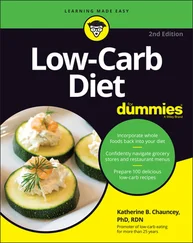Determining what you need to dispose of
No one can promise you that your home-canned foods will always be free from spoilage, but you can rest assured that your chances for spoiled food are greatly reduced when you follow the precise guidelines for each preserving method. However, if you suspect, for any reason, that your food is spoiled or just isn’t right, don’t taste it. Instead, take a time-out to better evaluate the contents. For starters, the best way to detect food spoilage is by visually examining your jars. Review the following checklist. If you can answer “true” for each of the following statements, then your food should be safe for eating:
The food in the jar is covered with liquid, is fully packed, and has maintained the proper headspace.
The food in the jar is free from moving air bubbles.
The jars have good, tight seals.
The food has maintained a uniform color.
The food isn’t broken or mushy.
The liquid in the jar is clear, not cloudy, and free of sediment.
After your food has passed this preliminary checklist, examine your jars more closely. Truth is, just because your food doesn’t look spoiled doesn’t mean that it’s not. If you discover any spoilage during any step of this process, don’t continue your search, but properly dispose of your product.
1 Hold the jar at eye level.
2 Turn and rotate the jar, looking for any seepage or oozing from under the lid that indicates a broken seal.
3 Examine the food surface for any streaks of dried food originating at the top of the jar.
4 Check the contents for any rising air bubbles or unnatural color.The food and liquid should be clear, not cloudy.
5 Open the jar.There shouldn’t be any spurting liquid.
6 Smell the contents of the jar.Take note of any unnatural or unusual odors.
7 Look for any cottonlike growth, usually white, blue, black, or green, on the top of your food surface or on the underside of the lid.
 Spoiled low-acid food may exhibit little or no visual evidence of spoilage. Treat any jars that are suspect as if they contain botulism toxins. Follow the detailed instructions for responsibly disposing of spoiled, low-acid food in Chapter 9. Never use or taste any canned food that exhibits signs of spoilage or that you suspect is spoiled. Boiling will not make spoiled food safe to eat.
Spoiled low-acid food may exhibit little or no visual evidence of spoilage. Treat any jars that are suspect as if they contain botulism toxins. Follow the detailed instructions for responsibly disposing of spoiled, low-acid food in Chapter 9. Never use or taste any canned food that exhibits signs of spoilage or that you suspect is spoiled. Boiling will not make spoiled food safe to eat.
 Removing the screw bands from your cooled, sealed jars before storing them allows you to easily detect any broken seals or food oozing out from under the lid, which indicates spoilage. Screw bands can also create a “false seal.” Screw bands that are left on jars can easily corrode and adhere to the jars, making them impossible to open safely.
Removing the screw bands from your cooled, sealed jars before storing them allows you to easily detect any broken seals or food oozing out from under the lid, which indicates spoilage. Screw bands can also create a “false seal.” Screw bands that are left on jars can easily corrode and adhere to the jars, making them impossible to open safely.
Part 2
IN THIS PART …
Discover why water-bath canning is the most popular canning method.
Find new recipes to preserve old favorites for more variety in your pantry.
Understand why water-bath canning is safe for certain foods and not for others.
Chapter 4
Come On In, the Water’s Fine! Water-Bath Canning
IN THIS CHAPTER
 Discovering water-bath canning
Discovering water-bath canning
 Recognizing high-acid foods
Recognizing high-acid foods
 Stepping up to high-altitude canning
Stepping up to high-altitude canning
 Knowing the proper processing procedures
Knowing the proper processing procedures
With water-bath canning, you essentially use a special kettle to boil filled jars for a certain amount of time. Common foods for water-bath canning include fruits and tomatoes, as well as jams, jellies, marmalades, chutneys, relishes, pickled vegetables, and other condiments.
You’re probably wondering whether water-bath canning is safe for canning food at home. Rest assured: The answer is a most definite “Yes!” — provided that you follow the instructions and guidelines for safe canning.
In this chapter, you discover which foods are safely processed in a water-bath canner and step-by-step instructions for completing the canning process. In no time, you’ll be turning out sparkling jars full of homemade delicacies to dazzle and satisfy your family and friends.
Water-Bath Canning in a Nutshell
Water-bath canning, sometimes referred to as the boiling-water method, is the simplest and easiest method for preserving high-acid food, primarily fruit, tomatoes, and pickled vegetables.
To water-bath can, you place your prepared jars in a water-bath canner, a kettle especially designed for this canning method (see the section, “ Key equipment for water-bath canning,” for more on the canner and other necessary equipment). You then bring the water to a boil and maintain that boil for a certain number of minutes, determined by the type of food and the size of the jar. Keeping the water boiling in your jar-filled kettle throughout the processing period maintains a water temperature of 212 degrees. This constant temperature is critical for destroying mold, yeast, enzymes, and bacteria that occur in high-acid foods.
 Water-bath canning is one of the two recommended methods for safely home-canning food (the other method is pressure canning, covered in Chapter 9). Although each processing method uses different equipment and techniques, the goal is the same: to destroy any active bacteria and microorganisms in your food, making it safe for consumption at a later time. This is accomplished by raising the temperature of the food in the jars and creating a vacuum seal.
Water-bath canning is one of the two recommended methods for safely home-canning food (the other method is pressure canning, covered in Chapter 9). Although each processing method uses different equipment and techniques, the goal is the same: to destroy any active bacteria and microorganisms in your food, making it safe for consumption at a later time. This is accomplished by raising the temperature of the food in the jars and creating a vacuum seal.
 Water-bath canning and pressure-canning methods aren’t interchangeable because the temperature of a water bath only reaches 212 degrees, while the temperature of a pressure canner reaches 240 degrees, the temperature necessary to safely process low-acid foods. Boiling for any amount of extra time should not replace the higher temperature of a pressure canner. For more on pressure canning, go to Chapter 9.
Water-bath canning and pressure-canning methods aren’t interchangeable because the temperature of a water bath only reaches 212 degrees, while the temperature of a pressure canner reaches 240 degrees, the temperature necessary to safely process low-acid foods. Boiling for any amount of extra time should not replace the higher temperature of a pressure canner. For more on pressure canning, go to Chapter 9.
Foods you can safely water-bath can
You can safely water-bath can only high-acid foods — those with a pH factor (the measure of acidity) of 4.6 or lower. So just what is a high-acid food? Either of the following.
Foods that are naturally high in acid: These foods include most fruits.
Low-acid foods that you add acid to, thus converting them into a high-acid food. Pickled vegetables fall into this category, making them safe for water-bath canning.You may change the acid level in low-acid foods by adding an acid, such as vinegar, lemon juice, or citric acid , a white powder extracted from the juice of acidic fruits such as lemons, limes, or pineapples. Some examples of altered low-acid foods are pickles made from cucumbers, relish made from zucchini or summer squash, and green beans flavored with dill. Today, tomatoes tend to fall into this category. They can be water-bath canned, but for safety’s sake, you add a form of acid to them.
Читать дальше

 Spoiled low-acid food may exhibit little or no visual evidence of spoilage. Treat any jars that are suspect as if they contain botulism toxins. Follow the detailed instructions for responsibly disposing of spoiled, low-acid food in Chapter 9. Never use or taste any canned food that exhibits signs of spoilage or that you suspect is spoiled. Boiling will not make spoiled food safe to eat.
Spoiled low-acid food may exhibit little or no visual evidence of spoilage. Treat any jars that are suspect as if they contain botulism toxins. Follow the detailed instructions for responsibly disposing of spoiled, low-acid food in Chapter 9. Never use or taste any canned food that exhibits signs of spoilage or that you suspect is spoiled. Boiling will not make spoiled food safe to eat. Removing the screw bands from your cooled, sealed jars before storing them allows you to easily detect any broken seals or food oozing out from under the lid, which indicates spoilage. Screw bands can also create a “false seal.” Screw bands that are left on jars can easily corrode and adhere to the jars, making them impossible to open safely.
Removing the screw bands from your cooled, sealed jars before storing them allows you to easily detect any broken seals or food oozing out from under the lid, which indicates spoilage. Screw bands can also create a “false seal.” Screw bands that are left on jars can easily corrode and adhere to the jars, making them impossible to open safely. Discovering water-bath canning
Discovering water-bath canning










